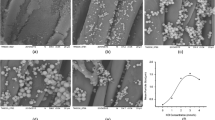Abstract
Monodisperse silica nanoparticles were prepared via miniemulsion sol–gel reaction of tetraethyl orthosilicate (TEOS). Hexadecane (HD) or hexadecyltrimethoxysilane was used as costabilizer to effectively retard the Ostwald ripening process involved in TEOS miniemulsion. The Ostwald ripening behavior was characterized by dynamic light scattering (DLS), and it was adequately described by the modified Kabal’nov equation. The miniemulsion sol–gel reaction of TEOS/HD with a volume fraction (φ c) of 0.024 at 80 °C is stable in the pH range 6–10. By contrast, gelation of reacting miniemulsions occurs at 70 and 100 min at pH 4 and 5, respectively. The weight-average silica particle size (d w) of colloidal products prepared at 80 °C and pH 7 decreases from 59 to 36 nm with low polydispersity index (PDI, in the range 1.02–1.03), determined by transmission electron microscopy, when the φ c of HD increases from 0.024 to 0.23. At constant φ c (0.024), the resultant silica nanoparticles show larger d w (83 nm) and PDI (1.35) for the TEOS/HD system at pH 10 as compared to the counterpart of pH 7. Furthermore, for the TEOS/HD system at pH 7 and low φ c (0.024), d w increases significantly with temperature being increased from 25 to 80 °C. By contrast, the effect of temperature on silica nanoparticle size becomes insignificant when a high level of HD (φ c = 0.23) is used. Zeta potential measurements and field emission scanning electron microscopy were used to characterize the surface charge density and morphology of resultant silica nanoparticles.






Similar content being viewed by others
References
Ying JY, Mehnert CP, Wong MS (1999) Synthesis and applications of supramolecular-templated mesoporous materials. Angew Chem Int Ed 38:56–77
Lin YS, Tsai CP, Huang HY, Kuo CT, Hung Y, Huang DM, Chen YC, Mou CY (2005) Well-ordered mesoporous silica nanoparticles as cell markers. Chem Mater 17:4570–4573
Quignard S, Mosser G, Boissière M, Coradin T (2012) Long-term fate of silica nanoparticles interacting with human dermal fibroblasts. Biomaterials 33:4431–4442
Zhang H, Dunphy DR, Jiang X, Meng H et al (2012) Processing pathway dependence of amorphous silica nanoparticle toxicity: colloidal vs pyrolytic. J Am Chem Soc 134:15790–15804
Lison D, Thomassen LCJ, Rabolli V, Gonzalez L, Napierska D et al (2008) Nominal and effective dosimetry of silica nanoparticles in cytotoxicity assays. Toxicol Sci 104:155–162
Yang L, Wang Y, Luo G, Dai Y (2006) A new ‘pH-induced rapid colloid aggregation’ method to prepare micrometer-sized spheres of mesostructured silica in water-in-oil emulsion. Microporous Mesoporous Mater 94:269–276
Lindberg R, Sjoblom J, Sundholm G (1995) Preparation of silica particles utilizing the sol–gel and the emulsion-gel processes. Colloids Surf A: Physicochem Eng Aspects 99:79–88
Yang LM, Wang YJ, Sun YW, Luo GS, Dai YY (2006) Synthesis of micrometer-sized hard silica spheres with uniform mesopore size and textural pores. J Colloid Interface Sci 299:823–830
Schiller R, Weiss CK, Geserick J, Husing N, Landfester K (2009) Synthesis of mesoporous silica particles and capsules by miniemulsion technique. Chem Mater 21:5088–5098
Nandiyanto ABD, Kim SG, Iskandar F, Okuyama K (2009) Synthesis of spherical mesoporous silica nanoparticles with nanometer-size controllable pores and outer diameters. Microporous Mesoporous Mater 120:447–453
Gustafsson H, Isaksson S, Altskär A, Holmberg K (2016) Mesoporous silica nanoparticles with controllable morphology prepared from oil-in-water emulsions. J colloid Interface Sci 467:253–260
Kabal’nov AS, Pertzov AV, Shikubin ED (1987) Ostwald ripening in two-component disperse phase systems: application to emulsion stability. Colloids Surf 24:19–32
Tauer K (2005) Stability of monomer emulsion droplets and implications for polymerizations therein. Polymer 46:1385–1394
Asua JM (2014) Challenges for industrialization of miniemulsion polymerization. Prog Polym Sci 39:1797–1826
Kabal’nov AS, Shikubin ED (1992) Ostwald ripening theory: applications to fluorocarbon emulsion stability. Adv Colloid Interf Sci 38:69–97
Taylor P (1998) Ostwald ripening in emulsions. Adv Colloid Interface Sci 75:107–163
Kabalnov AS, Makarov KN, Pertzov AV, Shikubin ED (1990) Ostwald ripening in miniemulsion: 2. Ostwald ripening in hydrocarbon emulsions: experimental verification of equation for absolute rates. J Colloid Interf Sci 138:98–104
Lin CT, Chern CS (2015) Modeling Ostwald ripening rate of styrene miniemulsions stabilized by a homolog of n-alkane costabilizers. J Taiwan Inst Chem Eng 49:240–246
Rehfeld SJ (1967) Adsorption of sodium dodecyl sulfate at various hydrocarbon-water interfaces. J Phys Chem 71:738–745
Porter DA, Easterling KE (1992) Phase transformations in metals and alloys, 2nd edn. Chapman & Hall, New York
Bergna HE (1994) Colloid chemistry of silica. Adv Chem 234
Hiemenz PC, Rajagopalan R (1997) Principles of colloid and surface chemistry, 3rd edn. Marcel Dekker, New York
Chern CS (2006) Emulsion polymerization mechanisms and kinetics. Prog Polym Sci 31:443–486
Chern CS (2008) Principles and qpplications of emulsion polymerization. Wiley, New Jersey
Rao KS, El-Hami K, Kodaki T, Matsushige K, Makino K (2005) A novel method for synthesis of silica nanoparticles. J colloid Interf Sci 289:125–131
Acknowledgement
This study was supported by Ministry of Science and Technology, Taiwan (Grant number 105-2221-E-011-152). The authors declare that they have no conflict of interest.
Author information
Authors and Affiliations
Corresponding author
Electronic supplementary material
Below is the link to the electronic supplementary material.
Rights and permissions
About this article
Cite this article
Pham, QT., Yao, ZH., Wang, YT. et al. Preparation and characterization of monodisperse silica nanoparticles via miniemulsion sol–gel reaction of tetraethyl orthosilicate. J Mater Sci 52, 12706–12716 (2017). https://doi.org/10.1007/s10853-017-1402-1
Received:
Accepted:
Published:
Issue Date:
DOI: https://doi.org/10.1007/s10853-017-1402-1




